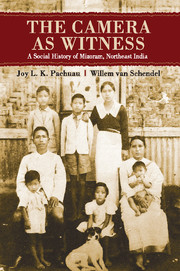Book contents
- Frontmatter
- Contents
- List of Figures
- List of Maps
- Acknowledgements
- I Becoming Mizo
- II Mizoram in the New India
- III Visions of Independence
- 17 Famine and Revolt
- 18 The Mizoram Government at Home and in East Pakistan
- 19 The Mizoram Government in Burma, China and Bangladesh
- 20 A State and its Minorities
- IV Mizo Modernities
- Copyrights and Sources
- Glossary
- Bibliography
- Index
19 - The Mizoram Government in Burma, China and Bangladesh
from III - Visions of Independence
Published online by Cambridge University Press: 05 May 2015
- Frontmatter
- Contents
- List of Figures
- List of Maps
- Acknowledgements
- I Becoming Mizo
- II Mizoram in the New India
- III Visions of Independence
- 17 Famine and Revolt
- 18 The Mizoram Government at Home and in East Pakistan
- 19 The Mizoram Government in Burma, China and Bangladesh
- 20 A State and its Minorities
- IV Mizo Modernities
- Copyrights and Sources
- Glossary
- Bibliography
- Index
Summary
In 1969, the rebel Mizoram Government had fled to neighbouring East Pakistan and mounted military operations from camps just across the border. The president and foreign secretary had already moved to East Pakistan in 1966, and since then cabinet meetings were held in Mizoram without them. By 1971, however, unforeseen events overtook the Mizo fighters. A war of independence broke out in East Pakistan between the Pakistan armed forces and groups fighting for an independent Bangladesh. By December, Indian armed forces had invaded the territory and endorsed the new government. The Pakistanis were crushed and Bangladesh was born.
In the Chittagong Hill Tracts, where the Mizoram Government in exile had its bases, the Bangladesh Liberation War had not been very intense. The Bangladesh Liberation War pitted Bengali nationalists against the Pakistani army. The Chittagong Hill Tracts was the only district in East Pakistan/Bangladesh with a negligible Bengali population. Fighting certainly went on here, but until the very end, Pakistani control was more complete than elsewhere in the territory.
The collapse of Pakistan came as a complete surprise to the Mizo leadership. Suddenly they had lost their sponsors and protectors, found themselves surrounded by invading Indian forces and faced a new government that was hostile to them. The Mizos had local allies in the Pangkhua but they had alienated most other inhabitants of the Chittagong Hill Tracts – notably the Chakmas – by stealing paddy from the fields; extorting money, paddy and medicines; massacring the men of a village refusing to pay and displacing over 10,000 local families from the northern Chittagong Hill Tracts to make room for training camps for Mizos and other insurgents from northeast India.
At the end of the war, they had to clear out immediately to save their skin, but where to go? Most fighters crossed over to Mizoram and marched south unopposed until they reached Arakan in Burma, but this course of action was considered too risky for the president and his entourage, so they travelled south on the Bangladesh side of the border, fighting their way through several hostile encounters, before they, too, reached the tri-junction where India, Bangladesh and Burma meet, a mountainous and poorly controlled region, and from there into the mountains of Arakan (western Burma).
- Type
- Chapter
- Information
- The Camera as WitnessA Social History of Mizoram, Northeast India, pp. 341 - 358Publisher: Cambridge University PressPrint publication year: 2015

